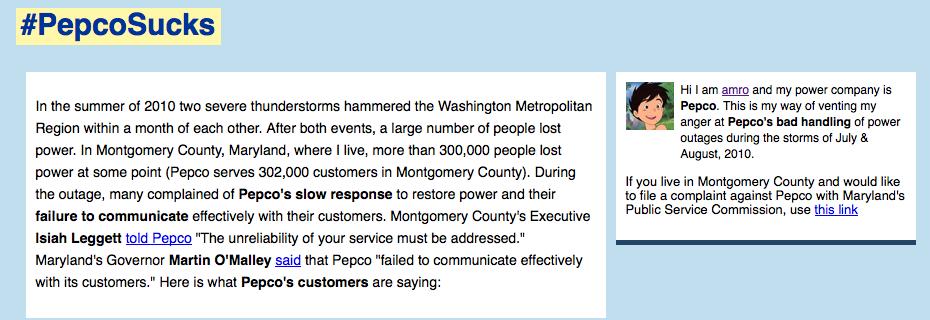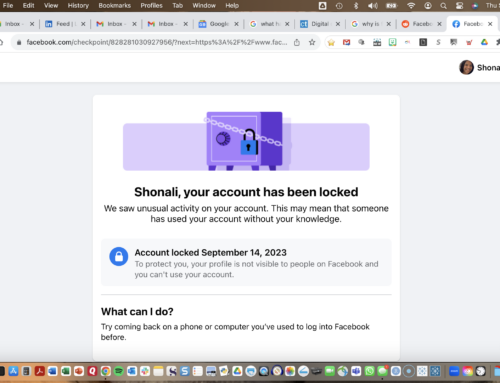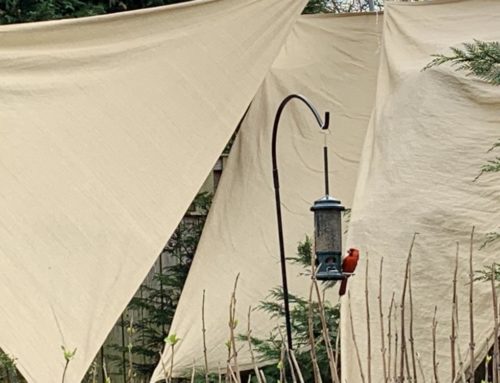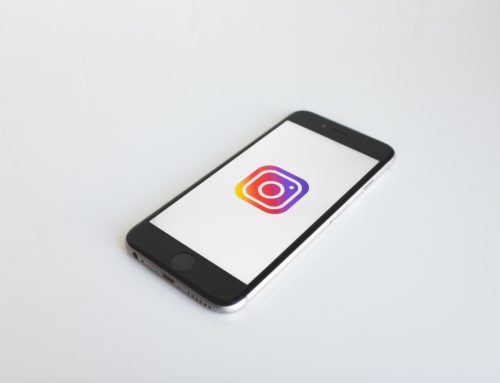I brought you up to speed on my conversations with Pepco and, more specifically, with Andre Francis, who manages the organization’s social media efforts.
Image: Féron Benjamin via Flickr, Creative Commons
As I continued thinking about it and how organizations approach social media in general, a couple of things became clear to me.
First, when companies – especially large ones – take the plunge into social media – they deserve our support, especially those of us who work in the field.
Who knows what internal battles have been fought in order for them to set up that Twitter account, or that Facebook page?
Second, even though companies who take the plunge should be acknowledged and applauded, having taken the plunge just isn’t enough any more.
They are now expected to engage and deliver not just rote communications, but customer service and dialog via social platforms on a regular basis.
People like Frank Eliason (in his previous life as @ComcastCares), Ford’s Scott Monty, and many others have set a high standard, and that’s the standard to which others are now being held.
So, if Pepco really wants to get ahead of the game, here are a few things it should consider, IMHO.
1. In an organization of this size, social media is not a one-person job.
Now, I don’t expect social properties to be monitored 24/7 on an average day.
In an emergency, though, I do, because when my power goes down, everything goes down. My phone line, my Internet connection, the food in my refrigerator starts rotting… everything is affected.
And to expect one person to manage the emergency response, particularly in emergencies of this magnitude, is unrealistic.
I’ve been there. I know what it’s like. It’s liable to drive one insane.
So if Pepco isn’t already beefing up its social media response team, it needs to get cracking on this.
If it can’t hire additional folks right now, cross-train those who are there.

Lisa says, “For major outages, we take an ‘all hands on deck’ approach, where we drop everything else, get all the major players in the same room, establish quick information flow and stay on top of all our outage communications, including Twitter.
“This frees up the resources and processes we need to respond helpfully in real time. This ‘drop everything’ response is part of a deeply ingrained corporate culture surrounding our commitment to restoring power quickly and offering clear communication about restoration estimates.”
2. Executives: how you say it is as important as what you say.
During last month’s outages, Charles Dickerson, Pepco’s VP of customer care, was quoted in local media as saying, “There are more important things to do,” when asked about communicating with customers.
Really?
There’s something more important than letting your customers know that you’re on the job – especially when the widely-held perception is that you’re not – and trying to get their power restored as quickly as possible?
Clearly restoring power is crucial, which is what Dickerson meant.
But no one likes to hear it’s not important to tell them – or at least give them an honest answer – as to when that happy moment might be.
Just ask BP chairman Carl-Henric Svanberg about what we “small people” think.
3. Update the phone system.

For example, during the last outage, whenever I called the customer care hot line, I was subjected to a recorded message telling me Pepco was experiencing high volumes of outages due to the storms in our area, blah blah.
Me: Yea, I know. I’m one of those people.
Why not create an option for those affected to bypass that message and go straight to reporting the outage?
The last thing I want to be told, when I have no power, is essentially to keep calm and wait for the beep.
Image: Louise Docker via Flickr, Creative Commons
4. Put monitoring to work.
During the early stages of my “interview,” I was told that Pepco uses Radian6 to monitor Twitter.
Radian6 is great, but what it’s not going to do is engage for the company.
Before I spoke with Andre, I read a Washington Post article shedding light on Andre’s plight as the primary recipient of online frustration towards Pepco.
I know it can’t be fun having to monitor #pepcosucks.
No more than it can be to realize someone has actually turned this into a web page.
(Hey, “Roger,” did you see that?)
But why not start commenting on these posts… not just on Twitter, but on blogs as well, wherever you can?
No, you’re not going to change everyone’s mind. But at least it’ll show you’re paying attention. And showing people you’re listening is the first step to making them feel they’re being heard.
5. Streamline, smarten and regularly update the company’s online presence.
For example
On Facebook
brand the Pepco Facebook page properly (which doesn’t have, at the time of this writing, any posts following August 12).
Andre, nice as he is, is not Pepco, and vice versa.
Pepco’s blog redirects to a “free” WordPress URL.
That’s not what I expect to see from a company the size of Pepco.
Why not incorporate that into the company’s domain (for example, pepco.com/blog – there’s an icon on the home page, but you can barely find it), make it a little more attractive (you can still use WordPress), and again… populate it more frequently?
If it’s too much of a hassle to re-engineer the domain (and I write this as a complete non-geek), secure a URL like PepcoPowersUp.com, or PepcoPower.com, or PepcoIsPower.com (in fact, I think you should do this any way).
They’re all available as of this writing (I checked).
There are any number of smart permutations of “pepco” and “power” with positive connotations that can be used.
Customize the theme using an inexpensive program like Headway, and boom, you’re off to the races.
On YouTube
Why not upload videos that don’t have such a produced feel more regularly?
This one, featuring Andre showing how to remove a battery from a thermostat is a start, but there’s so much more you could do.
Especially when a crisis hits, a Flip camera could be Pepco’s best friend, particularly to show how hard the team is working to get power restored.
Take short videos – they could be of teams on the ground, the Communication team (or Andre) responding to a comment a la Old Spice guy, anything.
Post them to YouTube, and then cross-promote them on Twitter, Facebook and the blog.
By doing this frequently, people will actually see the Pepco team in action… and reduce the feeling they have of being in the dark.
No pun intended.
6. Help your customers tell their stories.
No matter who we are, where we are, or what we do, we all love stories.
Why not tell Pepco’s story through its customers? Ask them to tell you their stories and then populate them on different platforms and cross-promote as above.
Are customers being creative while trying to save power? Did someone have a romantic candlelit evening instead of being glued to their laptops or TVs? Ask them. And tell that story.
Did a sudden power outage result in something pleasantly unexpected? Did they suddenly pay attention to the stars? Ask them. And tell that story.
Do you have a happy customer you helped out? ask them to send you a quick video. With their permission, post it. Tell that story.
 See, most of us don’t like being crabby all the time.
See, most of us don’t like being crabby all the time.
If a company does something nice for us – or helps us in some way – we want to tell other people.
So take advantage – in a nice way – of human nature.
7. 140 characters are great, but 160 characters are better.
In all the emergency communications I received during the last few power outages, my county’s system of using email and text alerts (both of which I’d signed up for) was impressive to me.
What was notable, however, was how not a single such communication came through from Pepco.
Consider implementing such tactics, as well as an email newsletter, which will fit in well with Pepco’s “green billing” initiative.
Pepco, you may already have thought of all this.
If so, now’s the time to get cracking. If not – well, here you go.
Consider this a free consult – in the public interest – from Shonali Burke Consulting.
What tips would you add, or have I gone bonkers? How are other companies handling crisis communication well in the age of social media?





![[EVENT]: PR Hacks for Small Biz (online)](https://shonaliburke.com/wp-content/uploads/2021/06/FB-Ad-1200x800-01-01-01-Copy-500x383.jpeg)





[…] have strong opinions on what they do, and don’t do, right from a communication point of view, but I’m eternally grateful to their crews on the […]
Hi there Shonali,
Wonderful post! I love how you go through Pepco’s needs to power up its business telecommunication requirements.
Well, hopefully it was useful to Pepco. :p
I’ve watched the video with Andre. And many years ago, I talked with Jarvis on the phone, and she does indeed seem like a delightful woman. And dealing with consumers is tough.
All that said, I think you’re going a little easy on Pepco. Let’s bullet out:
They first emailed you content that sounds like it could have come from a PR parody site
They leaped into social media with no strategy, figured they had to “because everyone else is”
They have laughably under-resourced and guaranteed it can never scale (if Andre leaves, do they go dark for three months?)
And they view social media as another way to “get our message out” (Andre’s term), not a way to listen to customers
When you have no strategy and no metrics, how do you know if you succeed or fail?
You’ll never get senior budget holders on board until you can justify the spend. I sure don’t know utilities, but maybe its reduced call center costs, something like that? How about inviting community leaders to be interviewed for the Pepco blog, make it contribute to CSR?
For my clients its thought leadership that begets lead gen, but clearly that’s not appropriate here.
Love how you’re calling me out, Chris. :)
I don’t know if I’m going easy on Pepco. Frankly, it took me a LONG time to pull these two posts together.
First, because I really wanted to hear Pepco’s side of the story and I was so dissatisfied with their initial response that I wanted to talk to Andre directly, and it took a while for both of us to connect.
Second, because I was SO irate when all this happened (i.e. the outages, their poor response), I needed time to calm down and write this as dispassionately as possible.
I completely agree with you that they have under-resourced their SM efforts. However, I don’t think they are alone in doing this; several organizations do. They think, hey, let’s set up a Twitterfeed/Facebook page/blog and oh, let’s have one person manage it all.
That’s fine to start with, but how on earth is one person expected to manage all this and scale it, as you point out?
In my conversation with Andre, he did allude to some “wins” in terms of actual measures, but did not give me specifics. I got the sense that there is an internal battle going on, which was why I tried to make this post as much about what they could/should be thinking of doing, as about how poorly their efforts come across. It doesn’t matter how many awards they win, but if their customers are not actually seeing the results of their efforts, what difference does it make?
Amen on this whole post, but especially your point that social media is not a one person job, especially at a company like Pepco. I think the way they’ve chosen to staff it–e.g. one person–indicates their understanding of why it’s important and their commitment to using it to advance their lackluster customer service. That is to say, they don’t really buy it but are basically doing lip-service to social media engagement. They’re getting the props and PR kudos (witness the Washington Post article and their recent PRSA award) without having to actually infuse social into their existing customer service and communication strategies. It’s very obvious that they consider social media to be a little add-on and/or an experiment, not a truly integrated part of a larger whole. So, that said, unless they suddenly “get it” I don’t see them investing in more staff or seeing the necessity to re-tool existing positions to include social media monitoring and/or response. Which is a shame, but pretty much universal at this point, I’m afraid.
Maggie, thanks so much for your comment. To be fair to Pepco, I do think the communication team understands the importance of two-way communication and hence, their SM presence. What I think is going on – and it’s only my sense, since no one from the organization has indicated this – is that there is an internal issue with staffing and perhaps management is not as yet convinced of the need for ramping up. So in that sense, yes, it does seem to be an experiment. I just hope something – if not this post, perhaps the combination of similar posts, tweets, etc. – will make them come to that realization soon.
Shonali, I think it was very generous of you to offer such solid advice to Pepco [or any other company that comes along to read your post].
“Who knows what internal battles have been fought in order for them to set up that Twitter account, or that Facebook page?”
This resonates with me having been on the inside on more than a few occasions (when I wasn’t with an agency) trying to be the internal champion for social media.
The challenge is that it’s often a continued uphill battle even after the Twitter account is secured. And then there are the issues of time, resources and let’s not forget talent. Not all employees are natural at being social.
The other huge challenge (social media or not) is branding. What is the brand’s promise to its customers? And does everyone care to uphold that promise? If not silos, budgets and politics can’t get the best of people.
As I said, I think you’ve been very generous with your advice, but sometimes I wonder if what is seemingly obvious to those of us who have already embraced social media (the concept) is really still decades away for most organizations. Just something to nibble on… ;-)
Beth Harte
Serengeti Communications
@bethharte
Beth, thanks so much for the thoughtful comment; I took a while to reply because I wanted to seep in before I did so.
I suppose yes, what is so obvious to us isn’t to others… and that’s why we do what we do. Maybe this post is something Pepco and other companies will take to heart, then… we’ll have to wait and see, I guess.
Thank you again!
Well said. Companies need to utilize Social Media because that is where customers are. They use sites to vent and to give praise. This is valuable feedback that companies should be paying attention to and they can only see those if they are using those platforms as well and using the search functions.
Let’s hope Pepco agrees with you, David. Thanks so much for stopping by!
In an organization of this size, social media is not a one-person job.
This is so so true. You do need a point person, but that person has to work cross-functionally to gather and then disseminate the information. Having worked through various crisis the point person has to be proactive in a) finding out the info that customers need; b) getting that information pulled together internally and c) working internally to create the updates that will work for the company and also for the customer.
It is a delicate balance but that role is so key in making sure you succeed in a crisis and that role has to be given the authority and support from all parts of the organization.
Great post! You should think about a crisis communication series. So many companies/people could have used it this past year – Toyota, BP, Lebron James, Johnson & Johnson, the egg companies behind the recall etc.
Raj, I think cross-functionality is a critical point organizations understand in principle, but it’s not that easy to work out in reality. I do think Pepco is trying, but unfortunately the perception is that it’s not.
A crisis communication series… oh boy! Wouldn’t that be something? :)
This is what I love about you–you speak the truth! I’m afraid even Pepco’s professional communicators don’t get it–they certainly don’t understand the needs of their customers, or they would be urging top management to institute the changes you suggest. Every time I hear one of Pepco’s insipid radio ads, I turn to another station, and I inform the station that aired the ad that I’ve tuned away. I am quite angry at the lack of response from Pepco to its customers; sometimes losing power can’t be prevented, but responding to customers should be a 24/7 job.
Aw, thanks for the vote of confidence, Marge.
To be fair to Pepco, I think Debbi, Andre and I’m sure many others on the team, do get it. I can’t help wondering what the internal dialog is like, though. As you and I know, it’s one thing to know what needs to be done, it’s a completely different ball game to actually be able to convince management to implement those changes.
That’s why I really tried to make this more of a “this is how you can” post, speaking both as a professional and Pepco customer, rather than a “why the heck aren’t you” post. Hopefully that came across!
Good advice for the behemoth, Shonali. I suspect it falls on deaf ears.
I agree with Jason that most companies (not just big ones, I would add) think of social media as a broadcast channel. They say “let’s set this up and be done with it.” They don’t see social media engagement as an activity that requires many person-hours per day, every single day.
Til they figure it out, I’ll just continue to be happy that I live outside of Pepco’s reach. :)
Thanks, Ann! You’re going to keep the rest of us jealous, eh?
I do think Andre’s handling of @pepcoconnect is decent. The problem is that we have so many examples of almost literally 24/7 response, that’s what we’ve come to expect, and in that measure, Pepco falls short.
I think these suggestions are great, but are we putting the cart before the horse with this one?
I would question if Pepco has a clear communications mission in mind for their online presence; if they see social networking as a tool to their communications plan, or see it as a channel that can be used to put into motion their overall strategic plan.
I think many companies of this size keep looking at social networking as a broadcasting channel.
I believe for them it is more important as a listening vehicle instead, that allows them to hear complaints, concerns, and overall sentiment. Reason being, is that strategies that incorporate social media and social networking prior to actually using it, lack the insights that social engagement provides and narrows the opportunity to maximize the channel as a valuable tool to overall communication operations.
“Cart before the horse” is a great way to put it Jason.
From what I was told, Pepco does indeed have a communication plan, though I wasn’t given specifics (to be fair, I only asked about crisis communication). I don’t know how they wouldn’t; in a company of that size, I imagine everything has to be written down and then some.
The point, though, as you say, is what does that plan consist of, and what is SM’s role in that plan – just another layer, or an integral channel to talk and respond to customers, let alone the media?
Listening is one of the great things that SM allows us to do. But if companies don’t show that they’re listening, i.e. by responding, to the good, bad and ugly, who’s to know they’re doing it? If a tree falls in the wood, etc. etc.